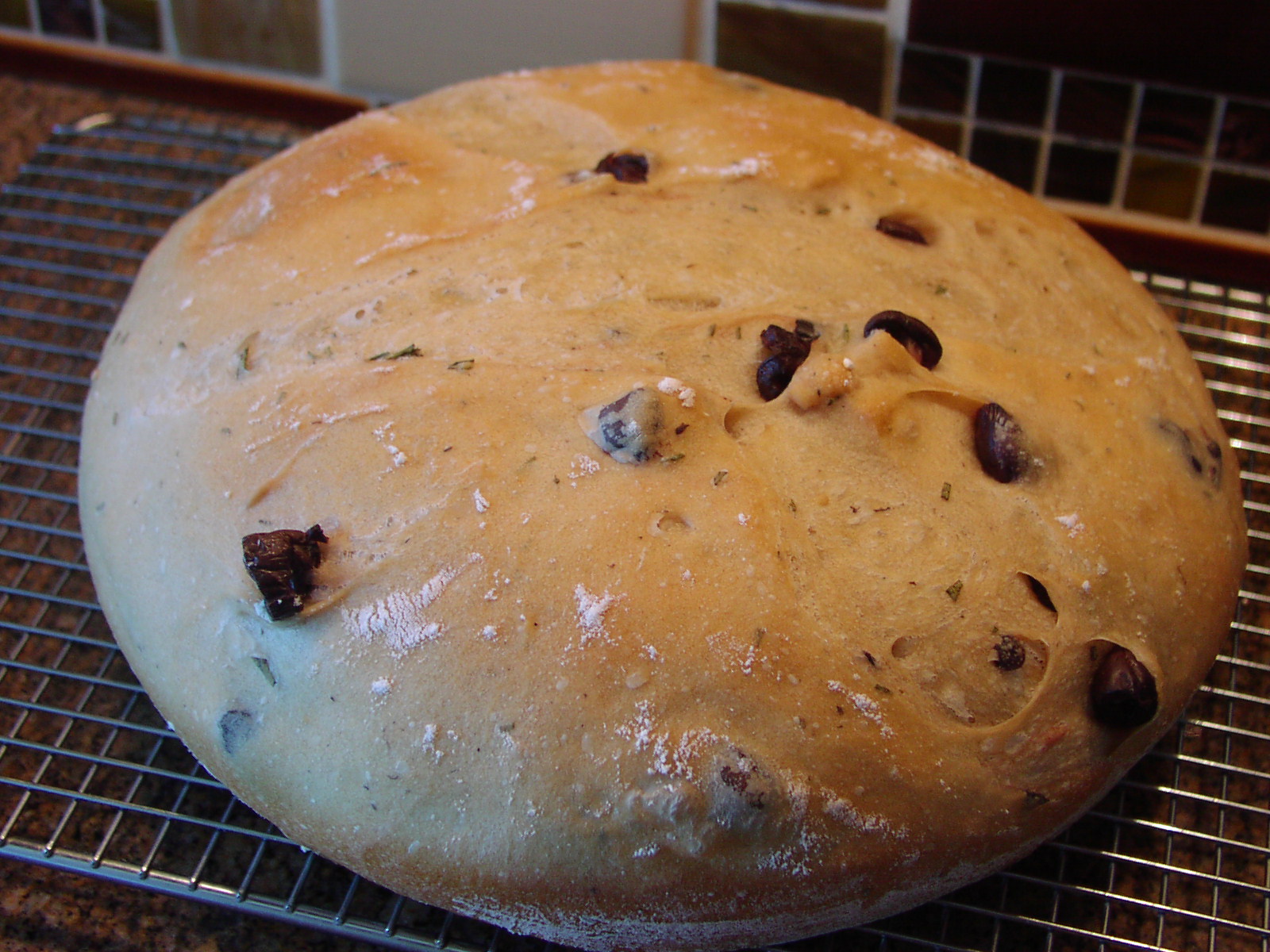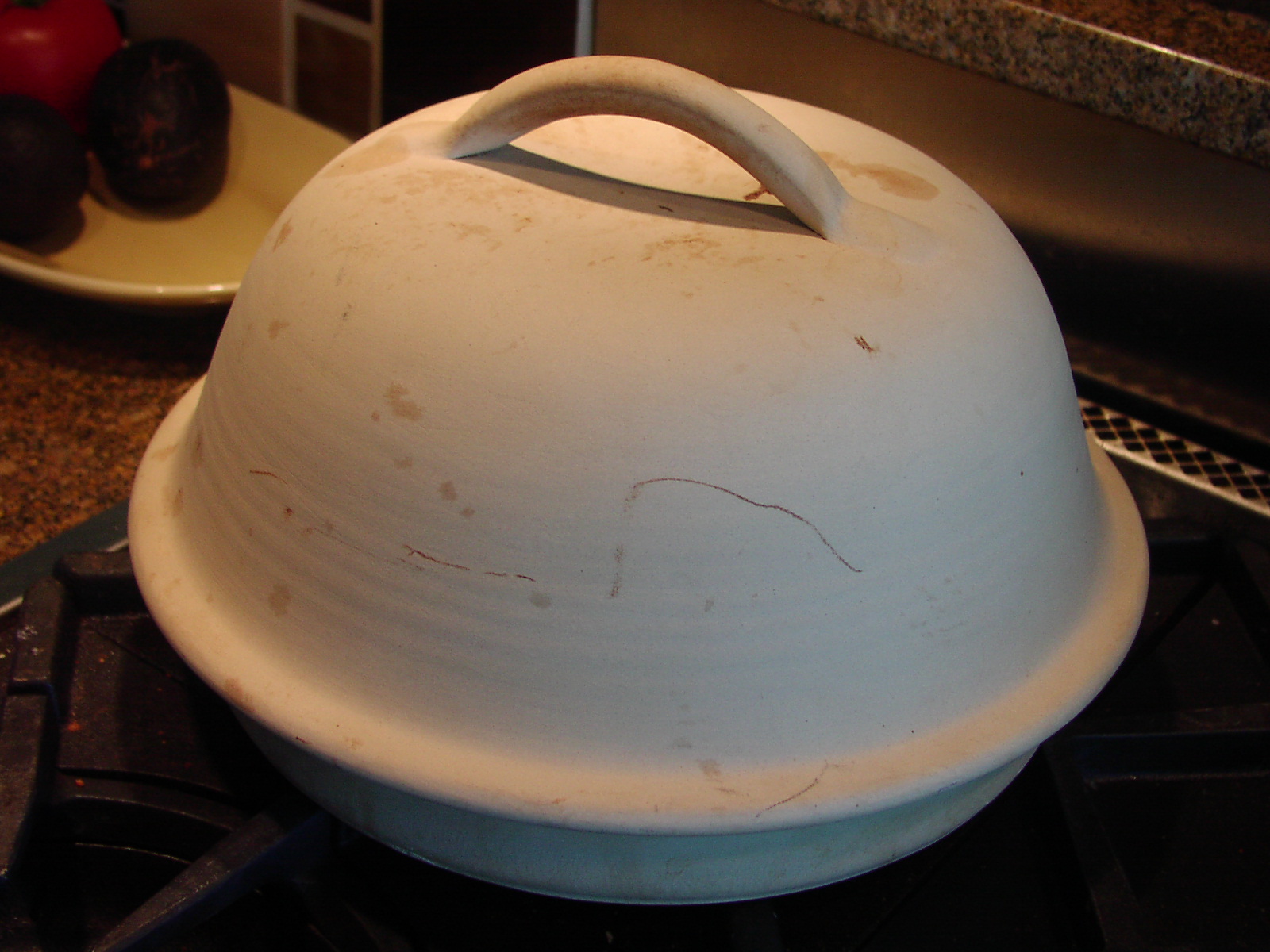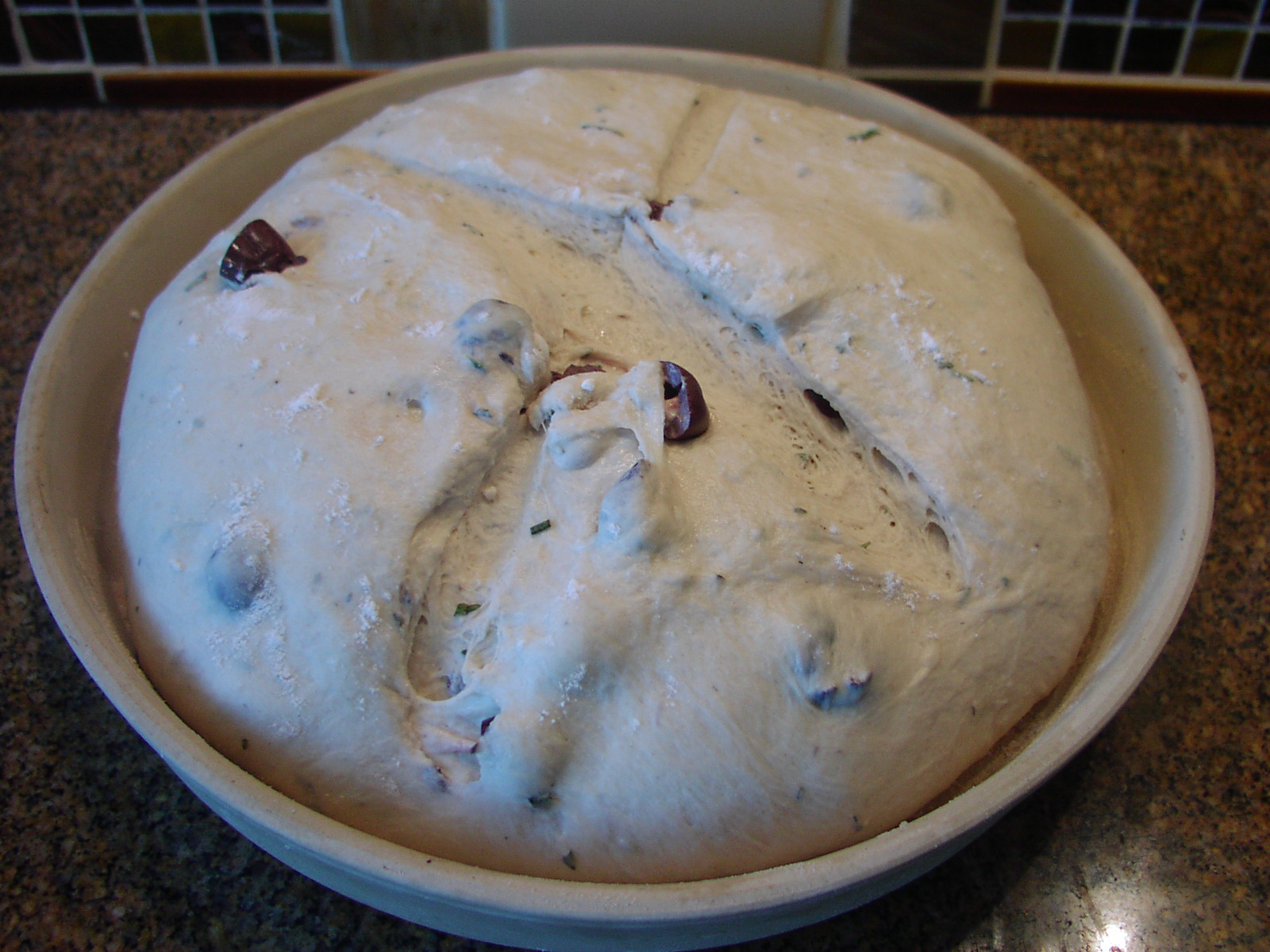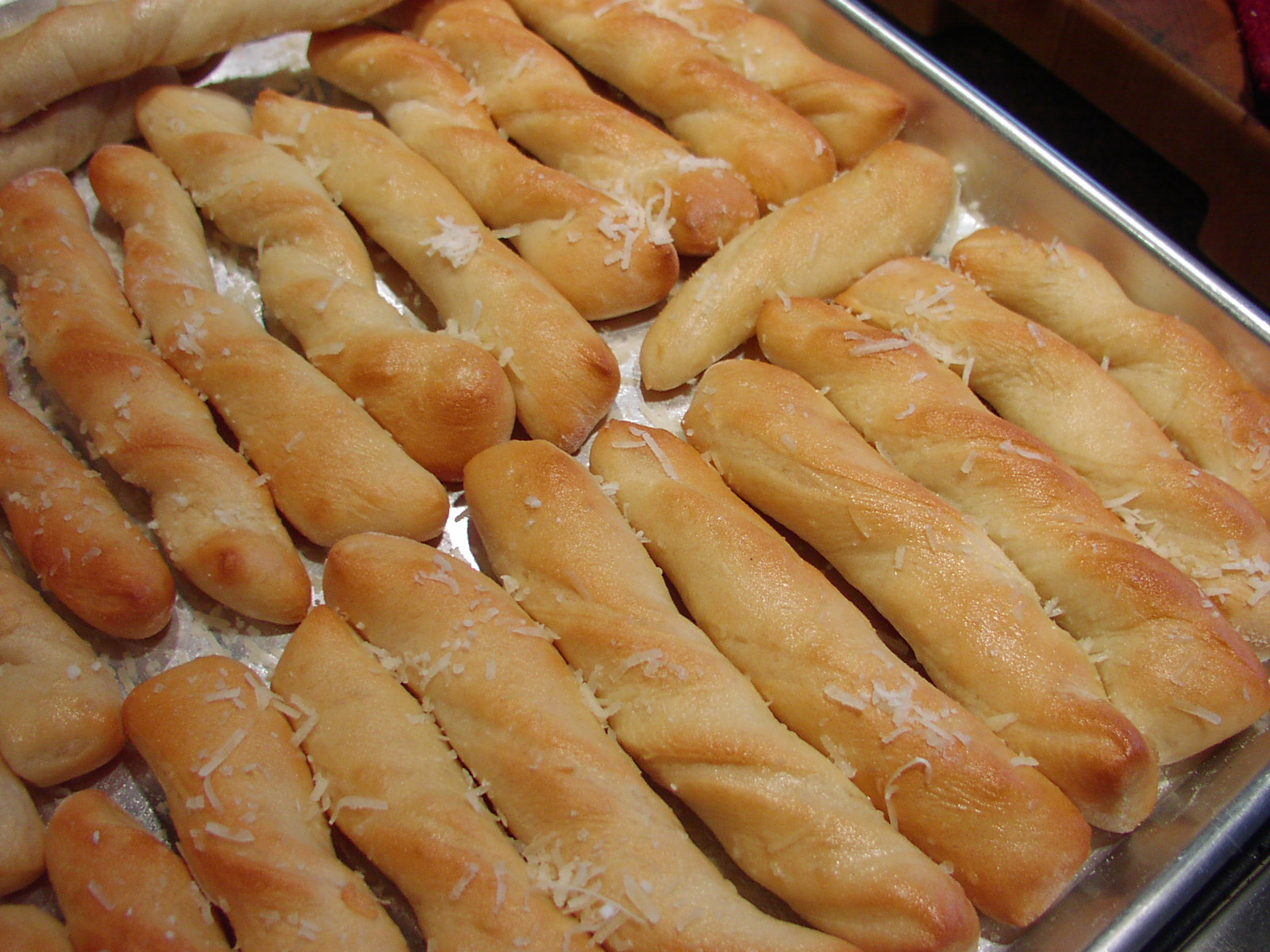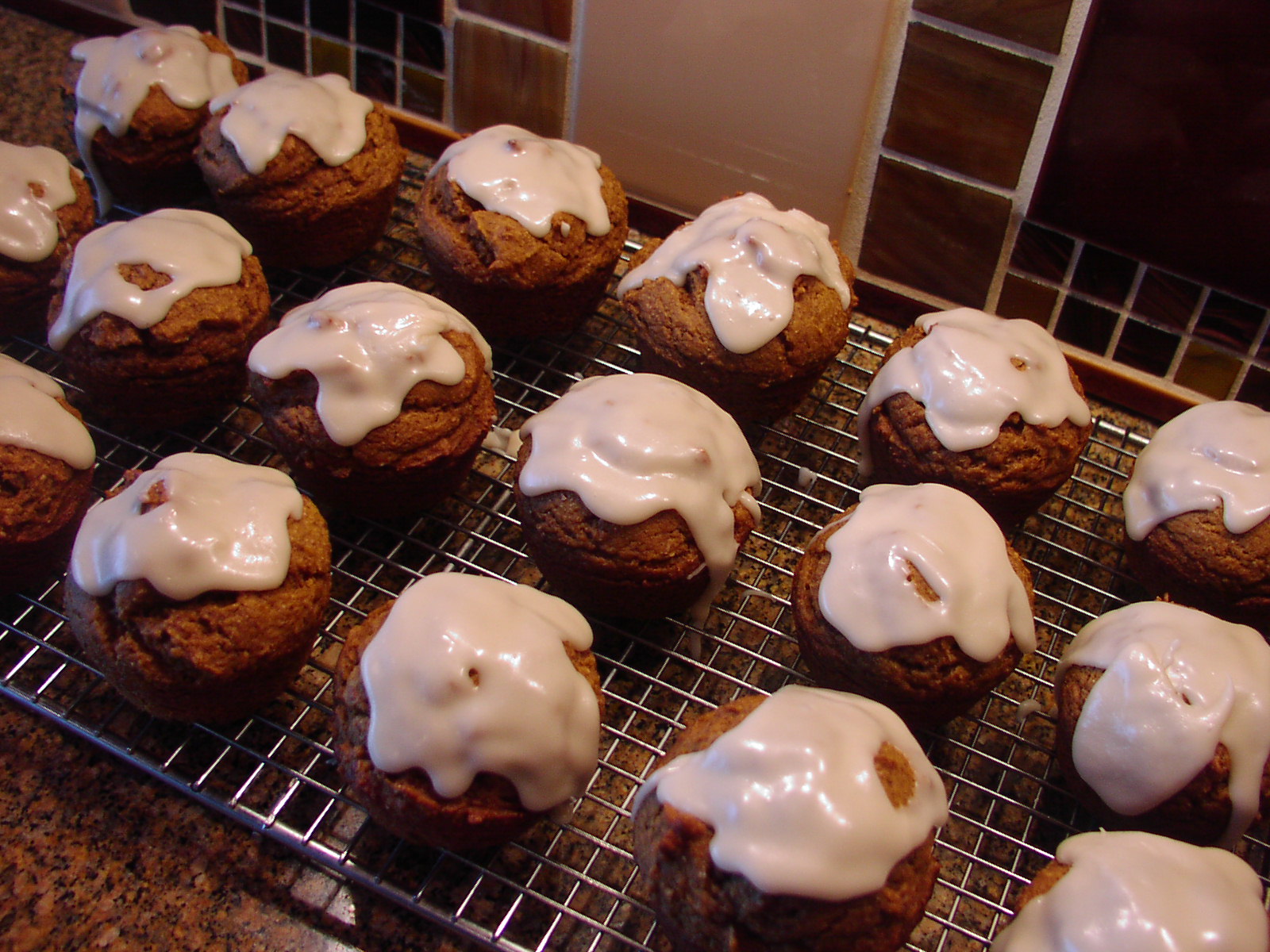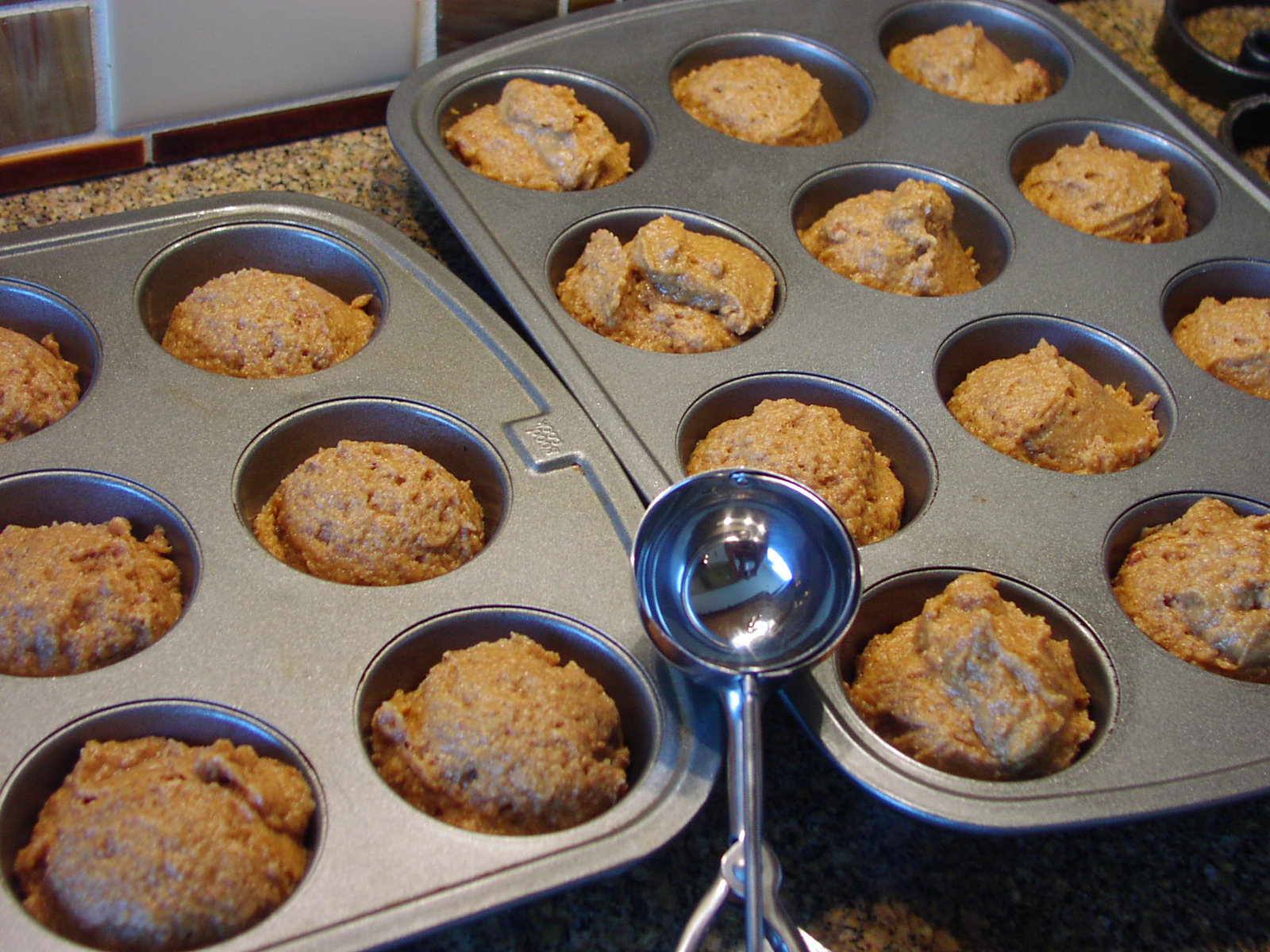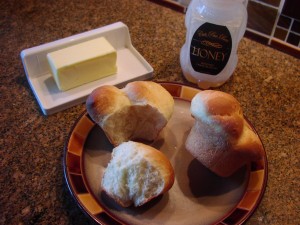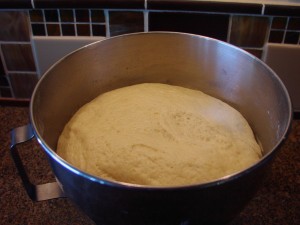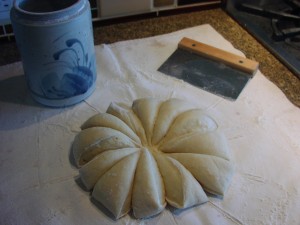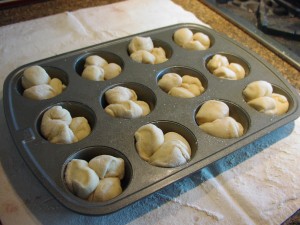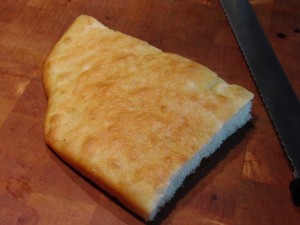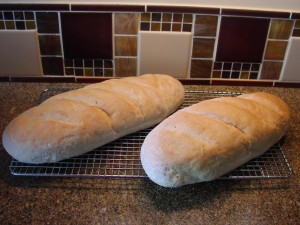
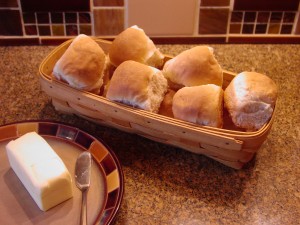
The first thing you need to know about baking yeast bread is that it is really easy. It does not require a chemistry degree or a diploma from a fancy cooking school. Honest! It just takes time and a few simple, inexpensive ingredients. In fact, I think yeast bread is easier to bake than cake or cookies because it doesn’t contain baking soda or baking powder.
With any type of recipe that requires baking powder or baking soda, you can’t mess around with the ingredients as much as you can when you are using yeast as your leavening agent. Baking soda (sodium bicarbonate) is alkaline in nature, and when combined with an acid and a liquid like buttermilk, for example, it creates carbon dioxide bubbles, giving rise to the dough. Baking powder, which is basically a blend of an acid like sodium acid pyrophosphate and an alkali (sodium bicarbonate – baking soda), produces the same chemical reaction when added to a liquid. Again, carbon dioxide is the byproduct. The interesting part about baking soda when mixed with an acid liquid, and baking powder when mixed with any liquid, is that in both cases, gases begin to be released immediately. (No waiting time required.) And in the case of double-acting baking powder (which is mostly what you find in your average grocery store), it releases leavening gases on contact with moisture and again during the baking process. A double whammy of leavening action! When a recipe calls for both baking powder and baking soda, the baking powder does most of the leavening. The baking soda is mainly added to neutralize some of the acid and to help ensure a tender crumb. When using baking soda or baking powder, you have to use ingredients in a fairly exact proportion.
Yeast on the other hand, is a living organism that really likes to eat. Active dry yeast (a living microscopic fungus) is activated by giving it a nice warm bath and then something yummy to eat. Yeast works as the leavening agent in bread dough by eating the sugars (sucrose and fructose) or by converting the starch in flour into sugar. The byproduct of all this sugar being gobbled is CO2. When CO2 is released it is trapped in the bread dough’s elastic web of gluten, in much the same way air is trapped when a balloon is inflated. And although yeasty beasties are hungry little cuties, they can only eat so fast! Thus the time it takes for yeast bread to rise. But unlike other leavening agents, yeasty beasties won’t stop eating until they have metabolized every possible bit of sugar available. So when you are baking bread, if you add a little extra ingredient here and there like extra oil, some dried onion or an herb or two, or need a little more flour than the recipe calls for – no problem. (In fact your little friends the yeasty beasties will love you all the more!) So it is truly pretty darn hard to mess up bread dough.
There are some bread bakers out there who swear by their bread machine. I had one once, and yes there was swearing involved. But in my case the words were aimed at the machine, not to offer it praises. The bread wasn’t bad, it was just boring. Frankly all the bread machine recipes tasted the same. And the texture or crumb was disappointing. Give me a KitchenAid mixer complete with a bread hook attachment any day over a bread machine. And yes, I cheat. I use my mixer because I’m lazy and frankly my hands aren’t as strong as they used to be! But in my defense, I know after 40 some years of using a heavy duty mixer to prepare bread dough that my mixer is never going to do me wrong. But if you enjoy kneading bread by hand, by all means please do so. (More about kneading bread in the Glossary and to follow in the Bread Baking Instructions.)
So in order to help you with your first few loaves of bread, or to help you improve your bread baking technique, I am going to include some recipes for very basic breads and I’m going to tear the recipes apart, bit by bloody bit. (If you are not a novice, please bear with me as I try to help those who are beginners.) And just for the record – no one is born gluten impaired. Everyone can learn to make great bread. There is no such thing as a predisposition to fail when working with gluten!
So have fun baking bread. It truly is not rocket science (although there is some science involved). And if you get stuck, just send me an email and I will help any way I can. apcarr08@wavecable.com
The first recipe we are going to make together is Foccacia. I choose this recipe because at first sight it appears to be terribly complicated with lots and lots of ingredients. But when you stop to really examine the ingredient list and the instructions, they are really quite straight forward and there are only 6 ingredients in the bread itself. 6 ingredients!
But before we go any further, I thought it best for you to become acquainted with the basic ingredients you will be using to bake yeast bread. (Not all breads have all of the ingredients listed below.)
BASIC YEAST BREAD INGREDIENTS:
Eggs – Eggs add richness, color, and wonderful flavor to bread.
Fats – Oil, butter, and shortening add flavor to bread and make for a tender crumb. (Do not use reduced fat products, whipped butter, or margarine when baking bread because they contain water and the composition of the dough will be weakened and the quality of your bread will be negatively affected.)
Flour – Flour is the basis of good bread. Be sure to use a good quality flour; one that is untreated with either bleach (powdered bleach belongs in your laundry, not in your bread), or potassium bromate, a suspected carcinogen. The flour you choose for your bread makes a difference in the quality of the final product. If you are a beginning bread baker, I would advise following recipes as written.
Unbleached all-purpose flour works just fine in most bread recipes.
Bread flour usually makes for a superior loaf, but for rustic bread, unbleached all-purpose flour is your best choice.
Whole grain flours and other types of flour add color, texture, and flavor to breads. These flours don’t usually contain enough gluten to produce a perfect loaf on their own, so usually all purpose or bread flour is added to provide structure.
Cake flour does not work for bread because there isn’t enough protein, or gluten, to withstand the pressure of the gasses created by the metabolizing yeast.
Liquid – When liquid is added to flour, two proteins, glutenin and gliadin, combine to form gluten. Gluten forms a network of proteins that stretch through the bread dough like a web, trapping air bubbles that form as the yeast ferments. This creates the characteristic air holes of perfect bread. The type of liquid you use will change the bread characteristics. Water will make a loaf that has more wheat flavor and a crisper crust. Milk and cream-based breads are richer and possess a finer texture. They also brown more quickly because of the additional sugar and butterfat added to the dough.
Salt – Salt is essential to every bread recipe. It helps add flavor, contribute to good texture, and control yeast development which prevents bread from over rising.
Sweeteners – White sugar, brown sugar, corn syrup, agave, molasses, honey, maple syrup, concentrated fruit syrup are all examples of the type of fuel that is needed by yeast in order to produce carbon dioxide. (Some bread recipes don’t use sugar, but depend on sugars in the flour to provide food for the yeast.)
Yeast – the leavening agent used to make bread dough rise. (I use Active Dry Yeast purchased in bulk (4-oz. jars which equals 16 envelopes) which tends to be fresher and definitely less expensive than buying the individual little packages. I don’t recommend rapid-rise yeast (unless it is specifically called for in a recipe) because the longer the rise (and fermentation process), the better the flavor.
BREAD RECIPES:
FOCCACIA
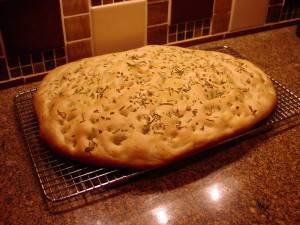
- 1 1/3 c. warm water
- 1 T. or 1 pkg. active dry yeast
- 2 tsp. sugar
- 1 ½ tsp. kosher salt
- about 1/2 c. extra virgin olive oil, divided
- 3 1/2 c. unbleached all-purpose flour
Pour warm water into a mixing bowl, sprinkle with yeast, and stir in sugar, salt, and ¼ cup of the olive oil. Let rest (proof) for 5-8 minutes. (Refer to Basic Instructions #1 below) Add two and a half cups of the flour and knead (Refer to Basic Instructions #2) for 4-5 minutes adding flour as needed to make a smooth and soft dough. (Refer to Basic Instructions #3) Round dough up in the bowl, pour a little olive oil over the top, and turn dough with your hands (the best tool in your kitchen, by the way) until the entire surface is coated. (Refer to Basic Instructions #4) Cover with a tea towel and let rest for an hour or until it has doubled in size. (Refer to Basic Instructions #5) Pour about a tablespoon of the remaining olive oil on a rimmed baking sheet. Punch down the dough (Refer to Basic Instructions #6), remove it from the bowl, and place it on the greased baking sheet. Pat dough out until it is about ½-inch thick. (It should not be a perfect rectangle.) Poke deep indentations all over the surface. Slather enough of the remaining olive oil over the dough to completely cover the surface. Sprinkle with salt and pepper and toppings of choice. (see below) Let rest for about 30 minutes. (Refer to Basic Instructions #7), Bake in a pre-heated 425 degree oven for about 15 minutes or until golden brown. Let bread cool on pan for about 5 minutes before transferring to a cooling rack. Serve warm or at room temperature.
Toppings:
large crystal sea salt or kosher salt, freshly ground black pepper
Vegetable Choice (pick one or more)
chopped onion,coarsely chopped pitted kalamata olive, sun-dried tomato packed in oil, 3-4 garlic cloves, chopped, sliced mushrooms
Cheese Choice (pick one or more)
crumbled feta, shredded parmesan cheese, diced goat cheese, shredded mozzarella cheese, crumbled blue cheese
Herb Choice – 1 tsp. (pick one or more)
rosemary, basil, oregano, thyme, chives
BEER BREAD
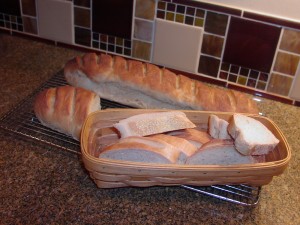
- 12-oz. bottle of beer (I like Alaskan Amber)
- ¼ c. water
- 2 tsp. kosher salt
- 2 T. sugar
- 2 T. butter
- 2 T. yeast (or 2 pkgs.)
- 5 c. flour
- cornmeal
Heat beer, water, salt, sugar, and butter until very warm. Pour into the bowl of your stand mixer. Allow to cool to proper temperature for yeast to be added, about 105 degrees F. Add yeast; allow liquid mixture to sit (proof) for about 5 minutes. (Refer to Basic Instructions #1) Add enough flour to make a stiff dough. (almost feels dry to the touch) Knead for about 5 minutes. (Refer to Basic Instructions #2&3) Add a tiny bit of vegetable oil to the bowl and coat the entire surface. (Refer to Basic Instructions #4) Cover and allow dough to rise until doubled, about 45 minutes; punch down. (Refer to Basic Instructions #5) Let rest 15 minutes. Shape in 2 long rolls on cornmeal covered pan. (Refer to Basic Instructions #8) Let rest another 15 minutes. Meanwhile, place a pan with 2-3 cups of water on the bottom rack of your oven and preheat the oven to 425 degrees. (Refer to Basic Instructions #9) When the oven is hot and the bread is risen and ready to be baked, place bread pan on a rack in the middle of the oven. Quickly close the oven door to capture the steam. Bake for about 25 minutes or until loaves are golden brown and sound hollow when lightly tapped. (Refer to Basic Instructions #10) Serve bread warm with lots of lovely, room temperature butter.
LIGHT RYE BREAD
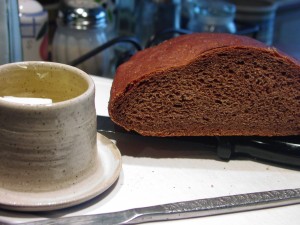
- 2 T. or 2 pkgs. active dry yeast
- 2 1/2 c. warm water
- 2/3 c. molasses
- 1 T. kosher salt
- 1/4 c. vegetable oil
- 1/4 c. cocoa powder
- 2 c. rye flour
- 5 c. bread flour
- cornmeal
In the bowl of a heavy duty mixer, dissolve the yeast in the warm water; add the molasses. Let proof for about 10 minutes. (Refer to Basic Instructions #1) Add salt, vegetable oil, cocoa powder, 2 cups of the rye flour and 2 cups of the bread flour. Mix until all of the flour is absorbed. Add the remaining 3 cups bread flour until the dough pulls away from the bottom of the bowl and the dough is smooth and elastic. (This step may take more or less than 3 cups of bread flour.) (Refer to Basic Instructions #2) Pour a small amount of vegetable oil over the dough, turning it so it gets coated in the oil. (Refer to Basic Instructions #4) Cover the bowl with plastic wrap. Let rise at room temperature until it has doubled in size, about 90 minutes. After 90 minutes, gently punch down the dough and divide it into 2 equal parts. Shape each half into a torpedo shaped loaf (Refer to Basic Instructions #8) and place both loaves well separated on a greased baking sheet that has been lightly sprinkled with corn meal. Cover with a clean tea towel. Let rise again for about 45 minutes. Just before placing in a pre-heated 350 degree oven, cut 5 shallow diagonal slashes across each loaf. Bake for 40-50 minutes or until the bread sounds hollow when gently tapped. (Refer to Basic Instructions #10)
PICNIC BUNS

- ¼ c. warm water
- 1 T. or 1 pkg. active dry yeast
- ¾c. warm, scalded milk (not too warm or your yeasty beasties won’t be happy)
- ¼ c. sugar
- 1 tsp. salt
- 1 egg, room temperature
- ¼ c. Crisco (sometimes I use butter – sorry grandma)
- 3 ½ c. or more flour
- vegetable oil
In a large mixing bowl, (I use the bowl of my Kitchen Aid mixer), combine the water, yeast, milk, sugar, salt, egg, and Crisco. Let proof for about 10 minutes. (You’ve got the idea by now!) Add 2 cups of the flour and mix thoroughly. Add enough remaining flour to form a medium stiff dough. (Not sticky when you touch it with your finger, but not dry feeling either.) Pour about a teaspoon of oil over the dough and roll into a ball. When dough ball is completely greased, cover the mixer bowl with a tea towel, let rise for about 90 minutes or until doubled. Punch down and let rise again until doubled, about 30 minutes. Butter a 9×13-inch pan. Punch down dough again and divide into 18 pieces. (I just squeeze off small balls of dough as I place them into the prepared pan.) Cover with a tea towel again, and let rise for 30 minutes or until doubled in size. Bake in a pre-heated 400 degree oven for 12-15 minutes or until a nice golden brown. Serve warm.
BASIC INSTRUCTIONS
1) The secret to getting your yeast to perform as required is to treat it right. Yeast loves warm liquid and just gets all warm and fuzzy if at the same time it is sitting in the tepid liquid, it is given a little nibble of something on which to munch. In most cases, it’s a wee bit of sugar or honey, but sometimes it’s just some flour. If the yeast is behaving properly, and you haven’t given it too hot a bath or it’s already gone to its happy home in yeasty heaven, after a couple of minutes you will see little bubbles form around the rim of the bowl. Then after a few more minutes it will look like the liquid is alive. This is what you want. You have proven that the yeast is not only happy, it is alive and well. It is safe to go on to the next step in your recipe. BTW, if your liquid doesn’t start to churn, you either used water which was too hot, or your yeast is dead. Pay close attention to the expiration date on your package or container of yeast. If the yeast is past its prime, toss it and start over with a fresh package.
2) To knead bread dough by hand, place it on a floured surface. Pick up the far edge of the dough and fold it over the bottom edge. Press down with the heels of your hands, pushing the dough away from you. Turn the dough one quarter turn and repeat the process. Add additional flour as needed. When properly kneaded, bread dough will be smooth and satiny, stretchy and no longer sticky. This process takes anywhere from 5-10 minutes.
To knead bread dough using a heavy duty mixer like a KitchenAid, add most of the flour called for in your recipe. Continue adding the remaining flour in very small increments until all of the dough pulls away from the bottom of the bowl. (It will look like someone cleaned the bowl for you.)
3) Will look smooth and slightly shiny, almost satiny.
4) Many recipes will instruct you to get a clean bowl, grease it with shortening, and place the kneaded dough in the new bowl and turn it so all surfaces are greased. Ridiculous! Use the bowl in which you originally mixed your bread ingredients! Pour a little oil down over the bread, and with your hands roll the dough into a ball making sure that every bit of the surfaced is lovingly covered with a thin film of oil.
5) Tea towels or plastic wrap help keep the dough warm and draft-free while the yeast does its magic. During this time the dough should double in size. To make sure your dough has risen sufficiently, poke it with 2 fingers. If the dough holds the indentation, it’s ready.
6) We punch dough down after the initial rising for several reasons: to relax the gluten, get rid of some of the carbon dioxide formed by the yeast, and to equalize the temperature. A couple of gentle punches are sufficient. (This is not the time to think of the IRS!)
7) Allowing the bread dough to rise again just adds volume and makes for a softer crumb.
8) Use your hands to shape the dough. Divide the dough in half and basically just roll each piece and stretch it in the air with your hands to the desired shape before placing it on prepared baking sheet. (Refer to the picture to see general desired shape.)
9) In the first few minutes of baking, loaves of bread will rise rapidly as the gases trapped inside expand and the yeast has a final burst of activity. Steaming within this time helps keep the crust soft. This allows the bread to continue expanding freely. The steam that has settled on the surface of the bread also dissolves sugars in the dough. As the bread stops expanding and the steam begins to evaporate, the sugars are left to caramelize and create a glossy crust.
10) Bread literally sounds like a hollow drum when it is baked. But tap gently, don’t pound on it like you are trying to wake up a teenager by knocking on his or her bedroom door at 11:00 on a Saturday morning.
GLOSSARY
CRUMB – the soft inner portion of a bread (distinguished from crust)
FIRST RISE – This is the initial fermentation when yeast produces carbon dioxide bubbles that leaven the bread. The first rise (fermentation) usually takes about 1 to 1 1/2 hours. After the first rise, the dough is punched down to get rid of some of the carbon dioxide formed by the yeast, to relax the gluten a little, and to equalize the temperature.
KNEAD – Bread dough is kneaded to distribute the yeast and develop gluten for an even texture or crumb.
To knead bread dough by hand, place it on a floured surface. Pick up the far edge of the dough and fold it over the bottom edge. Press down with the heels of your hands, pushing the dough away from you. Turn the dough one quarter turn and repeat the process. When properly kneaded, bread dough will be smooth and satiny, stretchy and no longer sticky. This process takes anywhere from 5-10 minutes.
To knead bread dough using a heavy duty mixer like a KitchenAid, add most of the flour called for in your recipe. Continue adding the remaining flour in very small increments until all of the dough pulls away from the bottom of the bowl. (It will look like someone cleaned the bowl for you.)
PROOF – Measure out the yeast and mix it with the water called for in the recipe. Yeast is happiest at about 75°-80°, so the water should feel barely warm or lukewarm to the touch. Add just a pinch of sugar or whatever ingredients are called for in the recipe to give the yeast something on which to munch. Let the yeast and water sit for a few minutes. First, the water will dissolve the dry coating around the granules of yeast, releasing the active yeast inside. The active yeast will go to work on the sugar and a bubbly foam will start to form on the surface from the carbon dioxide being released. This foam is “proof” that the yeast is active, and once you see it, you know the yeast is alive and well and will leaven your dough.
SECOND RISE (PROOFING) -After you’ve punched down the dough, you want to gently knead it again while it is still in the bowl. Then shape the bread according to the recipe instructions and let it rise again until it nearly doubles in size (which will take less time than the first rising). Sometimes bread will not rise as much the second time as the first. Again, it’s important that the bread rise in a warm, draft-free area. To test for doneness, again use the finger test. Poke it with 2 fingers; if it holds the indentation, it’s ready.
WARM (TEPID) WATER – Yeast needs a warm liquid to wake up. I define the perfect temperature for yeast to be happy as about the same temperature in which you would bathe a new born baby. Lukewarm. Not hot. Not cold. Slightly warm.
YEAST – the leavening agent used to make dough rise. Yeast is actually a living microorganism. And this darling little critter lives just to convert fermentable sugars into (among other things) carbon dioxide.

